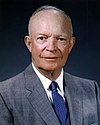
In atomic physics, the Bohr model or Rutherford–Bohr model, presented by Niels Bohr and Ernest Rutherford in 1913, is a system consisting of a small, dense nucleus surrounded by orbiting electrons—similar to the structure of the Solar System, but with attraction provided by electrostatic forces in place of gravity. It came after the solar system Joseph Larmor model (1897), the cubical model (1902), the Hantaro Nagaoka Saturnian model (1904), the plum pudding model (1904), the quantum Arthur Haas model (1910), the Rutherford model (1911), and the nuclear quantum John William Nicholson model (1912). The improvement over the 1911 Rutherford model mainly concerned the new quantum physical interpretation introduced by Haas and Nicholson, but forsaking any attempt to align with classical physics radiation.

Dwight David "Ike" Eisenhower was an American military officer and statesman who served as the 34th president of the United States from 1953 to 1961. During World War II, he served as Supreme Commander of the Allied Expeditionary Force in Europe, and achieved the five-star rank of General of the Army. He planned and supervised the invasion of North Africa in Operation Torch in 1942–1943 and the invasion of Normandy from the Western Front in 1944–1945.
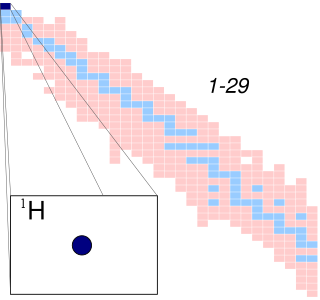
A hydrogen atom is an atom of the chemical element hydrogen. The electrically neutral atom contains a single positively charged proton and a single negatively charged electron bound to the nucleus by the Coulomb force. Atomic hydrogen constitutes about 75% of the baryonic mass of the universe.

Niels Henrik David Bohr was a Danish physicist who made foundational contributions to understanding atomic structure and quantum theory, for which he received the Nobel Prize in Physics in 1922. Bohr was also a philosopher and a promoter of scientific research.
In atomic physics, the Bohr magneton is a physical constant and the natural unit for expressing the magnetic moment of an electron caused by either its orbital or spin angular momentum. The Bohr magneton is defined in SI units by
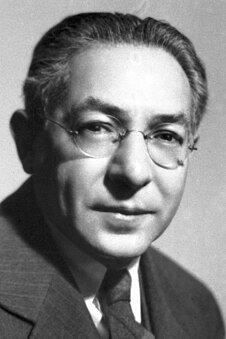
Isidor Isaac Rabi was an American physicist who won the Nobel Prize in Physics in 1944 for his discovery of nuclear magnetic resonance, which is used in magnetic resonance imaging. He was also one of the first scientists in the United States to work on the cavity magnetron, which is used in microwave radar and microwave ovens.

William Pierce Rogers was an American diplomat and attorney. He served as United States Attorney General under President Dwight D. Eisenhower and United States Secretary of State under President Richard Nixon. Despite Rogers being a close confidant of Nixon, National Security Advisor Henry Kissinger overshadowed Rogers and eventually succeeded him as Secretary of State. Rogers was the last surviving member of the cabinet of Dwight D. Eisenhower.

John Clarke Slater was a noted American physicist who made major contributions to the theory of the electronic structure of atoms, molecules and solids. He also made major contributions to microwave electronics. He received a B.S. in Physics from the University of Rochester in 1920 and a Ph.D. in Physics from Harvard in 1923, then did post-doctoral work at the universities of Cambridge (briefly) and Copenhagen. On his return to the U.S. he joined the Physics Department at Harvard.

Mary Geneva "Mamie" Eisenhower was the first lady of the United States from 1953 to 1961 as the wife of President Dwight D. Eisenhower.
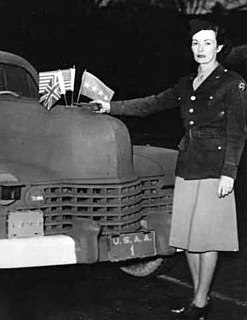
Kathleen Helen Summersby, known as Kay Summersby, was a member of the British Mechanised Transport Corps during World War II, who served as a chauffeur and later as personal secretary to Dwight D. Eisenhower during his period as Supreme Commander Allied Expeditionary Force in command of the Allied forces in north west Europe.
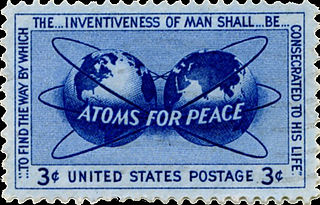
"Atoms for Peace" was the title of a speech delivered by U.S. President Dwight D. Eisenhower to the UN General Assembly in New York City on December 8, 1953.
I feel impelled to speak today in a language that in a sense is new—one which I, who have spent so much of my life in the military profession, would have preferred never to use. That new language is the language of atomic warfare.

The Dwight D. Eisenhower Presidential Library, Museum and Boyhood Home is the presidential library and museum of Dwight David Eisenhower, the 34th president of the United States (1953–1961), located in his hometown of Abilene, Kansas. The museum includes Eisenhower's boyhood home, where he lived from 1898 until being appointed to West Point in 1911, and is also the president's final resting place. It is one of the thirteen presidential libraries under the auspices of the National Archives and Records Administration (NARA)

James Rhyne Killian Jr. was the 10th president of the Massachusetts Institute of Technology, from 1948 until 1959.

The Draft Eisenhower movement was a widespread political movement that eventually persuaded Dwight D. Eisenhower, former Chief of Staff of the United States Army, to contest the presidency of the United States.

The Atomic Energy Act of 1954, 42 U.S.C. §§ 2011-2021, 2022-2286i, 2296a-2297h-13, is a United States federal law that covers for the development, regulation, and disposal of nuclear materials and facilities in the United States.

Gerard Coad Smith was an American attorney and defense expert who served as the chief U.S. delegate to the Strategic Arms Limitation Talks (SALT) in 1969 and the first U.S. Chairman of the Trilateral Commission. He was awarded the Presidential Medal of Freedom on January 16, 1981 by President Jimmy Carter.
In chemistry and atomic physics, an electron shell may be thought of as an orbit followed by electrons around an atom's nucleus. The closest shell to the nucleus is called the "1 shell", followed by the "2 shell", then the "3 shell", and so on farther and farther from the nucleus. The shells correspond to the principal quantum numbers or are labeled alphabetically with the letters used in X-ray notation.
Laurin Luther Henry is an American academic. He worked as a researcher, consultant, and educator. He is considered an expert on the subject of United States presidential transitions.
Max Franklin Millikan was an American economist, Professor of Economics at MIT, Assistant Director of the Office of Research and Reports at the CIA, and director of the MIT Center for International Studies.
This bibliography of Dwight D. Eisenhower is a list of published works about Dwight D. Eisenhower, the 34th president of the United States.
